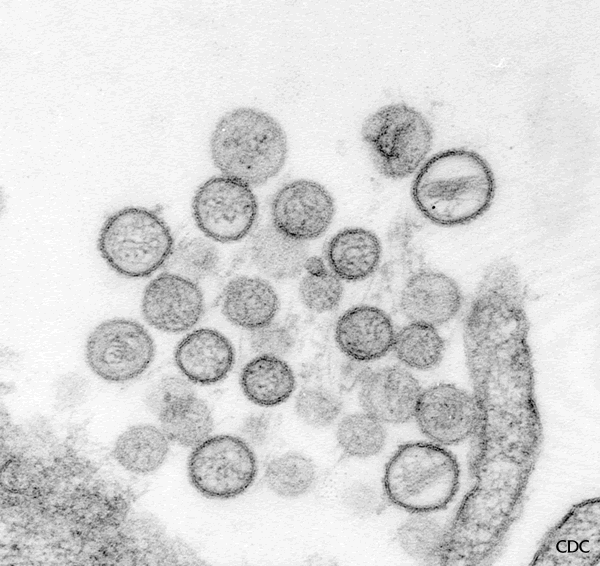Bunyavirus-Related Hemorrhagic Fevers
Crimean Congo Hemorrhagic Fever Virus
-
Crimean-Congo hemorrhagic fever (CCHF) virus is a tick-borne virus of the Nairovirus genus
-
1944: First characterized in Crimea during an outbreak among agricultural workers and subsequently called the Crimean hemorrhagic fever
-
1969: virus re-recognized as a cause of illness in the Congo
-
Found in Eastern Europe, northern China, central Asia, India, the Middle East, the Mediterranean, and Africa
-
Sudden onset of headache, high fever, back, joint & stomach pain, and vomiting
-
As illness proceeds, can lead to bleeding beginning on the fourth day of illness and lasting for two weeks
-
Diagnosed via ELISA and RT-PCR
-
Supportive treatment for fluid balance, also responds to ribavirin

Image from Centers for Disease Control Website
Rift Valley Fever Virus
-
Acute fever caused by Rift Valley Fever virus
-
Primarily infects domesticated animals but can also infect humans
-
Virus is of the Phlebovirus genus
-
Transmitted by mosquitoes (several species); outbreaks often occur during years of heavy rainfall and localized flooding
-
Generally found in eastern and southern Africa, where sheep and cattle are raised
-
Can lead to significant economic loss due to sick livestock
-
Spillovers into human populations have occurred, notably in 1977 in Egypt and 1987 in the Senegal River area
-
Diagnosed via ELISA and PCR during early phases of illness
-
Most human cases are mild and self-limiting
-
Most common complication for humans is an inflammation fo the retina, leading to 1-10% of patients to have permanent vision loss.
-
Incubation period of 2-6 days with fever, weakness, back pain, and dizziness as the most common symptoms

Image from Centers for World Health Organization
Hemorrhagic Fever with Renal Syndrome
-
Group of illnesses caused by hantaviruses, including Hantaan, Dobrava, Saaremaa, Seoul, and Puumala
-
Found around the world; each virus has a characteristic region
-
Eastern Asia: Hantaan virus
-
Europe: Puumala Virus
-
Balkans: Dobrava Virus
-
Worldwide: Seoul Virus
-
Central Europe & Scandinavia: Saaremaa Virus
-
Transmitted by rodents (natural reservoir); roden control is primary prevention
-
Typical incubation period of 1 to 2 weeks
-
Initial symptoms include sudden headaches, back and abdominal pain, fever, chills, nausea, and blurred vision
-
Later symptoms include low blood pressure, vascular leakage, and acute kidney failure, leading to fluid overload
-
Diagnosed via hantavirus antigen in tissue via immunohistochemical staining
-
Can be fatal

Image of Hantavirus from Virology Online
Selected Page Bibliography:
-
"Virus Taxonomy: 2014 Release." International Committee on Taxonomy of Viruses. http://ictvonline.org/virusTaxonomy.as
-
Fields Virology, 6th Edition, Chapter 42: Bunyaviridae
-
"Chapter 56: Bunyaviruses." Medical Microbiology. 4th edition. http://www.ncbi.nlm.nih.gov/books/NBK8004/
-
"Bunyaviridae." Viral Hemorrhagic Fevers (VHFs). Centers for Disease Control and Prevention. http://www.cdc.gov/vhf/virus-families/bunyaviridae.html
-
"Crimean-Congo Hemorrhagic Fever (CCHF)." Centers for Disease Control and Prevention. http://www.cdc.gov/vhf/crimean-congo/index.html
-
"Rift Valley Fever." Centers for Disease Control and Prevention. http://www.cdc.gov/vhf/rvf/index.html
-
"Hemorrhagic Fever with Renal Syndrome (HFRS)." Centers for Disease Control and Prevention. http://www.cdc.gov/hantavirus/hfrs/index.html